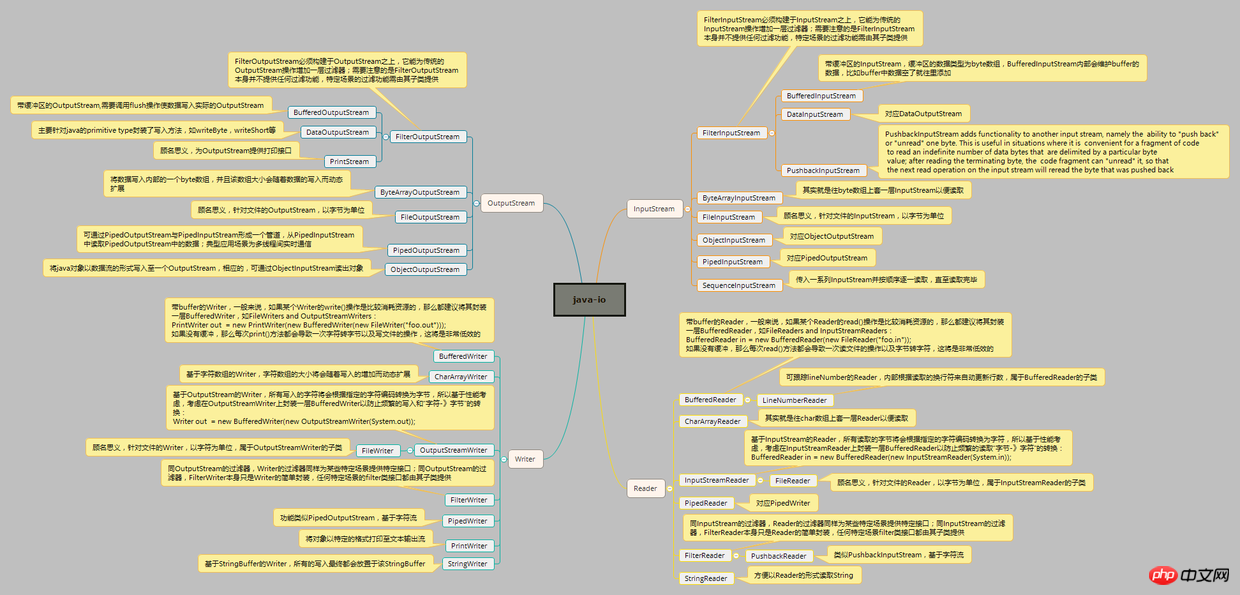
IO should be the most commonly used function in daily projects. Whether it is simple file reading or server port monitoring, IO will be used; however, when facing the Java IO package When using a complex IO basic class library, you often get confused. Should you choose InputStream or Reader? Should you add a to InputStream? Buffer? How to choose the appropriate class library according to the application scenario is a problem faced by many coders. Here I have sorted out the commonly used class libraries in the Java IO package, including their organizational structure, functional features, applicable scenarios, etc., to To facilitate subsequent use, you can quickly and easily select the most appropriate IO class according to your needs

According to the analysis diagram, IO can be divided into two dimensions from a large level:
Data type, that is: characters or bytes, class corresponding to Writer/Reader or OutputStream/InputStream
Operation type, that is: read (input) or write (output), the class corresponds to Reader/InputStream or Writer/OutputStream
All operations of Java IO are nothing more than extensions of the four main classes in these two dimensions. Most of them are relatively simple. Here are some points that are slightly difficult to understand and worth noting. A separate explanation
Java IO uses the Decorator pattern extensively, so generally when using the IO class library, the Decorator calling method is used:
PrintWriter out = new PrintWriter(new BufferedWriter(new FileWriter("foo.out")));In Java IO, whether it is the reading and writing of characters or the reading and writing of bytes, there is basically a one-to-one correspondence. In other words, there is a specific reading class. Generally, There will be a specifically written class. Grasping this can simplify the complex. For example, FileInputStream and FileOutputStream correspond to file reading and writing respectively;PipedInputStream and PipedOutputStream correspond to the reading and writing of pipe data respectively.
How to distinguish reading or writing is a problem that often troubles novices. , here I provide a simple way to distinguish: using the program you are currently running as the benchmark (that is, the program that calls IO), data transferred from the program to other places is written (output), and data transferred from other places to the program is read. (Input); if the data generated by the program is stored in the log file, then it is written. If the data is obtained from the port and processed in the program, it is read

Select the appropriate IO class for assembly based on the action to be performed and the target data type, combined with the usage scenario. Note that the above sentence actually involves three steps:
The action to be performed is to read or write.
The data type is byte or character, and sometimes Conversion of characters and bytes is required (such as OutputStreamWriter); if data needs to be stored on the network or in memory, it is generally in the form of bytes; or writing of files, text files This kind of character encoding itself is generally in the character form, but for pictures, videos and other files, it can only use the byte form
Usage scenarios, in fact, the usage scenarios need to be considered in two steps , first consider the obvious scenarios, such as file operations, string operations, or pipe communication; secondly, you need to consider performance, such as whether file writing operations will be more frequent. If so, it is recommended to encapsulate them through BufferedWriter, because It is a very inefficient way to open and write a small amount of data every time
This article mainly focuses on the basic IO classes Briefly sort out, and explain the basic concepts in IO and how to use the IO basic class library. Of course, this article does not list all IO implementation classes. Interested students can check the Java documentation or source code by themselves. At the same time, this article also How to customize the IO class library yourself? In fact, under normal circumstances, the basic class library provided by Java is enough to meet the needs; in addition, Java introduced NIO after 1.4, namely: No Blocking IO, which is somewhat different from the original IO usage scenarios
The above is the detailed content of A brief introduction to getting started with IO in Java (picture). For more information, please follow other related articles on the PHP Chinese website!




